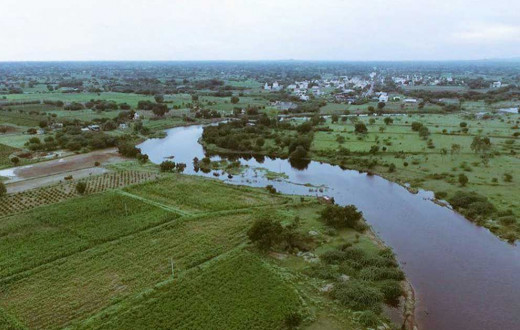Overview
Until a few years ago, the Vedavathi River, which emerges in the Chikmagalur Taluka of Karnataka, was a steady river that nurtured thousands of lives. But the pockets of the river slowly started disappearing, drawing the attention of Nagraj Gangolli, Director (Technical), The Art of Living’s River Rejuvenation Projects.
He studied the region and prepared a blueprint for rejuvenating the river. Initiated under the National Guaranteed Employment Scheme, the vision was to rejuvenate the 5,447 sq. Km area of the Vedavathi River, which flows between Chikmagalur and Hubli, thus benefiting 1.5 million people in 1097 villages.
Understanding the situation in Chikmagalur
Chikmagalur receives an average rainfall of about 1925 mm which is amongst the highest in the country. Yet as summer approaches, all lakes and rivulets go dry. Due to overutilization, the groundwater levels in the region had dropped below 1100 ft. in certain places, and irrigation was almost impossible.
Nearly 90% of the borewells in the catchment area of Vedavathi River had gone dry due to over-exploitation. The river that once used to flow throughout the year was restricted to a few months of monsoon.
In addition, deforestation and soil erosion over the last 20 years saw failed crops year after year in Chikmagalur, Hassan, Chitradurga, and Hubli districts.
What did we do?
Gangolli brought together a team of experts from renowned hydro-geologists, civil engineers supported by techno-functional GIS team and scientists of IISc, ISRO, and IT groups.
The team started meeting individual Gram Panchayats to explain to them the need to undertake comprehensive water management efforts and to build consensus. In six months, the team got support from 10 Gram Panchayats, thus covering all the 49 villages, and brought together the administrative machinery, including the individual Panchayat Development Officers and the CEO of Zilla Parishad.
Due to persistent efforts of the team, the funds were sanctioned under the Mahatma Gandhi National Rural Employment Guarantee Act (MGNREGA), and The Art of Living was declared the nodal agency to oversee the project implementation.
Rejuvenation work began with the implementation of a watershed management program, which included groundwater recharge, afforestation, and sustainable farming methods - practices which were guided by Art of Living’s research team.
What change did we bring?
Construction of recharge structures started in May 2014 after the general elections got over. In the tanks that have been constructed so far, the water levels have started rising due to the torrential showers that the region has received.
Data Collected by the Art of living's research team showed that in the last decade the cause of a river drying up was not failed monsoons, but mismanagement and unchecked overuse of water,year,after year.
The bigger change, however, is that due to our efforts, residents from over 49 different villages lying in the Vedavathi watershed have joined hands to tackle the problem. We have won the support of the district administrative machinery and the Rural Development and Panchayati Raj (RDPR) ministry. This partnership is vital to the success of the project.
How does the journey look so far?
Under Phase I
Rs. 6.17 crores sanctioned under MGNREGA for a comprehensive watershed management plan
Rs. 1.5 crore sanctioned by the Forest department to increase green cover
810 recharge structures (including boulder checks, recharge wells, and water ponds) undertaken
49 villages under 10 Gram Panchayats where structures have been built
Over 2000 people provided employment, generating 184,000-man days
Over 377 sq. Km covered
Under Phase II
- 188 crores sanctioned under MGNREGA
- 835 structures completed till date and 619 under progress
- 19,474 more structures to be built
- 1,06,795-man-days of work would be generated
- 3,000 trees to be planted
Learn Sudarshan Kriya, a powerful breathing technique driving our volunteer community with vitality and focus.
How did we work?
We have employed the following strategies for this project:
- Village level awareness campaigns (personal and group interaction) and tying up with individual Gram Sabhas
- Obtaining RDPR Sanction
- Identifying local leaders to lead the work, and working closely with them to build implementation teams
- Providing training to the teams on how the work will be executed
- Giving each Gram Panchayat a demo of the work to be done and how the compensation should be affected
- Leading each Gram Panchayat team to start the work and monitoring their work every day to complete the projects on time and within the stipulated budget
What did we learn?
- The loopholes in MGNREGA need to be covered to avoid delay in wage payments and other kinds of irregularities
- Mass awareness about MGNREGA needs to spread among the public
- Developmental work that involves the governmental bodies, as well as the civil society, requires high patience and perseverance on the part of the implementing organization
How can you contribute?
In Phase II of the project, the plan is to build a total of 21,800 structures spread across 1097 villages. The goal is to cover an area of 5447 sq. Km. Efforts of this scale would require massive financial support and resources. Individuals can offer their time to plant saplings and also choose to provide their technical and marketing expertise for successful completion of the project.







